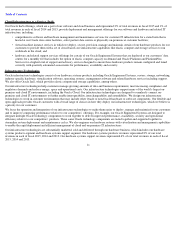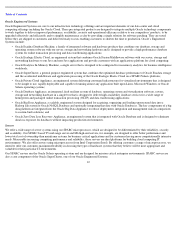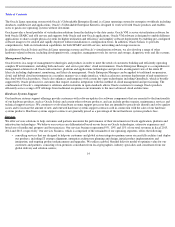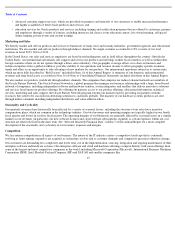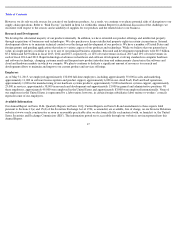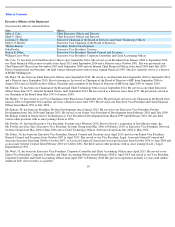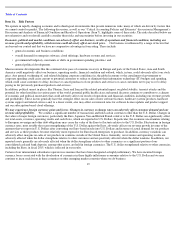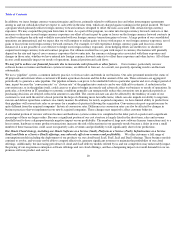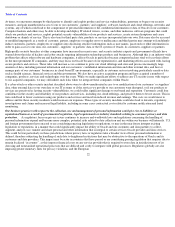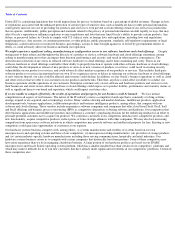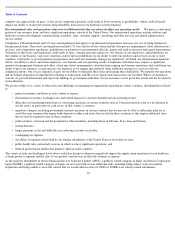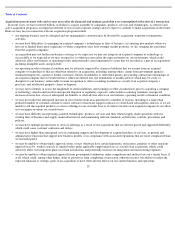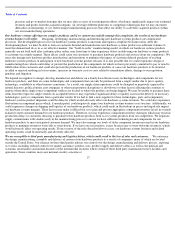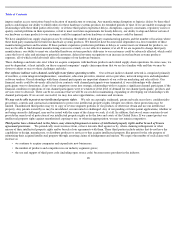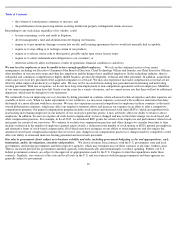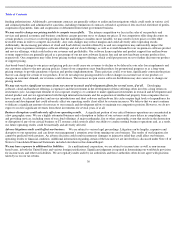Oracle 2014 Annual Report Download - page 24
Download and view the complete annual report
Please find page 24 of the 2014 Oracle annual report below. You can navigate through the pages in the report by either clicking on the pages listed below, or by using the keyword search tool below to find specific information within the annual report.
Table of Contents
In addition, we incur foreign currency transaction gains and losses, primarily related to sublicense fees and other intercompany agreements
among us and our subsidiaries that we expect to cash settle in the near term, which are charged against earnings in the period incurred. We have
a program which primarily utilizes foreign currency forward contracts designed to offset the risks associated with certain foreign currency
exposures. We may suspend the program from time to time. As a part of this program, we enter into foreign currency forward contracts so that
increases or decreases in our foreign currency exposures are offset at least in part by gains or losses on the foreign currency forward contracts in
an effort to mitigate the risks and volatility associated with our foreign currency transaction gains or losses. A large portion of our consolidated
operations are international, and we expect that we will continue to realize gains or losses with respect to our foreign currency exposures, net of
gains or losses from our foreign currency forward contracts. For example, we will experience foreign currency gains and losses in certain
instances if it is not possible or cost effective to hedge our foreign currency exposures, if our hedging efforts are ineffective, or should we
suspend our foreign currency forward contract program. Our ultimate realized loss or gain with respect to currency fluctuations will generally
depend on the size and type of cross-currency exposures that we enter into, the currency exchange rates associated with these exposures and
changes in those rates, whether we have entered into foreign currency forward contracts to offset these exposures and other factors. All of these
factors could materially impact our results of operations, financial position and cash flows.
We may fail to achieve our financial forecasts due to inaccurate sales forecasts or other factors. Our revenues, particularly our new
software licenses revenues and hardware systems revenues, are difficult to forecast. As a result, our quarterly operating results can fluctuate
substantially.
We use a “pipeline” system, a common industry practice, to forecast sales and trends in our business. Our sales personnel monitor the status of
all proposals and estimate when a customer will make a purchase decision and the dollar amount of the sale. These estimates are aggregated
periodically to generate a sales pipeline. Our pipeline estimates can prove to be unreliable both in a particular quarter and over a longer period of
time, in part because the “conversion rate” or “closure rate” of the pipeline into contracts can be very difficult to estimate. A reduction in the
conversion rate, or in the pipeline itself, could cause us to plan or budget incorrectly and adversely affect our business or results of operations. In
particular, a slowdown in IT spending or economic conditions generally can unexpectedly reduce the conversion rate in particular periods as
purchasing decisions are delayed, reduced in amount or cancelled. The conversion rate can also be affected by the tendency of some of our
customers to wait until the end of a fiscal period in the hope of obtaining more favorable terms, which can also impede our ability to negotiate,
execute and deliver upon these contracts in a timely manner. In addition, for newly acquired companies, we have limited ability to predict how
their pipelines will convert into sales or revenues for a number of quarters following the acquisition. Conversion rates post-acquisition may be
quite different from the acquired companies’ historical conversion rates. Differences in conversion rates can also be affected by changes in
business practices that we implement in our newly acquired companies. These changes may negatively affect customer behavior.
A substantial portion of our new software licenses and hardware systems contracts is completed in the latter part of a quarter and a significant
percentage of these are larger orders. Because a significant portion of our cost structure is largely fixed in the short-term, sales and revenue
shortfalls tend to have a disproportionately negative impact on our profitability. The number of large new software licenses transactions and, to a
lesser extent, hardware systems products transactions increases the risk of fluctuations in our quarterly results because a delay in even a small
number of these transactions could cause our quarterly sales, revenues and profitability to fall significantly short of our predictions.
Our Oracle Cloud strategy, including our Oracle Software as a Service (SaaS), Platform as a Service (PaaS), Infrastructure as a Service
(IaaS) and Data as a Service (DaaS) offerings, may adversely affect our revenues and profitability. We offer customers a full range of
consumption models including the deployment of our products via our cloud based SaaS, PaaS, IaaS and DaaS offerings. These business models
continue to evolve, and we may not be able to compete effectively, generate significant revenues or maintain the profitability of our cloud
offerings. Additionally, the increasing prevalence of cloud and SaaS delivery models offered by us and our competitors may unfavorably impact
the pricing of our on-premises enterprise software offerings and our cloud offerings, and has a dampening impact on overall demand for our on-
premises software product and service
20



